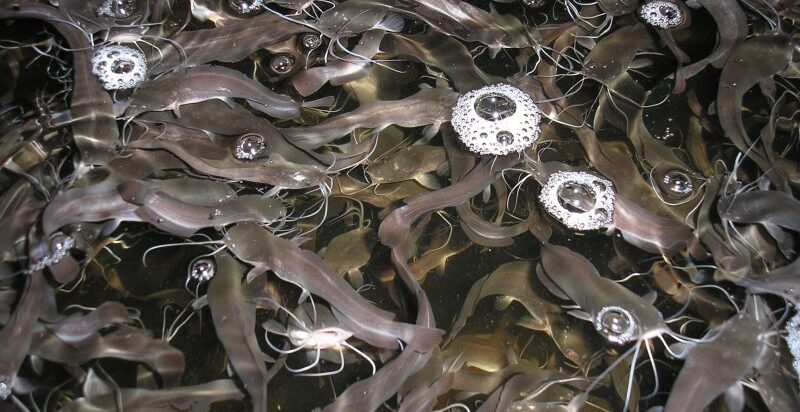Earn Money Making Catfish feed. Facts you need to know
Every intending fish farmer must know that fish feed takes a share of about 70-80% of the total cost of raising a fish, must especially the African mud catfish, so, the urge is high to reduce cost on feeding. Most people venture into fish farm business with their knowledge of the poultry industry, where it is very common for individual farmer to compound his own feed from concentrates procured from nearby local markets. Consequently, potential farmers want to go into fish feed production with this same idea. However, such is not absolutely applicable in the aquaculture industry.
Unlike fish feed, poultry feed is ‘put in a pot’ and not thrown into the water. In view of this, poultry feed is not necessarily pelletized, but can be a mash. Nevertheless, fish feed can never be a mash – in this case, it only pollutes the water.
Poultry feed is dominantly a vegetable diet with a limited inclusion level of fish meal. On the other hand, fish feed is much richer and needs a lot of animal protein (which is usually a limiting factor in production of fish feed) in order to give the fish the desired growth.
Furthermore, catfish is a carnivorous species, and can only eat highly digestible ingredients: “compare a lion that eats fresh meat to a cow that consumes only grass”. One can conclude that that is why the digestive tract of a catfish is similar to that of a lion, and in contrast to that of a cow (which has stomach, that is, rumen that can digest ingredients with very high fibre contents). In addition, unlike in poultry business, catfish feed production requires a long list of raw materials as well as more sophisticated/complicated machines to make a complete diet.
Specification of a good quality catfish feed
- Well balanced ration, with minimum crude protein and fat content of 40% and 10% respectively.
- Effective processing/milling of ingredients in order to improve their digestibility and stability.
- Moisture content of the feed should not be more than 10%, so as to avoid eventual fungal infestation.
- Uniformity of feed size: with each stage of catfish, there is a need for different sizes of feed with specific nutritional requirements.
The good thing is that Nigerians are not easily discouraged, and believe they can achieve their set goals. As a result, they go to a country like China to procure machines which are of different qualities. They, however, source for raw materials from suppliers from the local markets.
Necessary components of a good feed mill
- A well-structured building, taking the weather into consideration
- An air-conditioned store for raw materials and feed concentrates
- Intake bunker with weighing device
- Hammer mill
- Mixer
- Pelletizing machine or extruder (conditioning the pellet machine or extruder with steam)
- Dryer and cooler (which are more expensive than the extruder, and much bigger)
- Fat coater (optional, but advisable for good quality catfish feeds)
- Bagging and proper storage of finished products
- Ensuring Standard Operating Procedures (SOPs), that is, taking into cognizance quality control measures: Hazard Analysis and critical Point (HAACP) e.g. mini-laboratory for testing of microbial, aflatoxin levels, and so on.
However, having mentioned all these points, the main challenge is how to keep all these machines in good condition as well as the technical know-how of personnel.
More so, when purchasing raw materials, it is very important to give serious mindful thought to consistency, availability, good price, maximum and minimum level of inclusion and just a few to mention.
Raw materials are sold in many of our local markets, but care has to be taken to ensure that good quality raw materials are purchased. For example, comparative proximate analysis of fish meal and feather meal, revealed the same level of protein. But, feather meal is much lower in its protein quality, compare to fish meal. Generally in Nigeria, protein of animal origin from factories is not readily available. The simple reason is that those raw materials are not in sufficient quantities and the various slaughter houses do not utilize their slaughter waste ranging from dry animal meat meal, bone meal, good quality feather meal to blood meal. It is saddening that these raw materials are imported, consequently, making them to be very expensive.
Can we do this on a farm level?
As a rule of thumb, the minimum quantity a feed mill should produce in order to be cost-effective, considering its affordability of a good technology back up, should be about 10,000 tons of fish per annum. Despite this, most farms in Nigeria can hardly boast of fish production capacity of 1000 tons or more in a year.
More so, many local feed mills in Nigeria produce inferior feeds, some of which have never been evaluated in any feed experiment for their performances. Fish farmers buy them peradventure, because they are cheap, picked by the fish (because they are very hungry). A meticulous farmer, right from the very onset, should not be too interested in the price of a feed, but a need to know the quality of the feed and its performance. Unfortunately, majority of feed millers as well as fish farmers do not know the amount of feed needed to grow 1 kg of fish with a particular type of feed.
If the quantity of feed used to grow 1 kg of fish is known, then calculation of the direct cost of producing 1 kg of catfish becomes easy. This is what farmers should know on their own. All that is required is an effective record keeping. Interestingly, the expensive feed could be more effective than the cheap one. Having said these, a good quality feed gives the following additional advantages:
- Faster growth – more turnovers, with the farm actually producing more fish per year.
- Bigger fish – the bigger the fish, the better the price per kg
- Less pollution for good quality feeds
- More healthy fish with lesser mortality
The situation of fish feed in Nigeria
There is an increase in the number of feed millers in Nigeria, even with state of the art equipment and good technology back up from overseas, willing to partake in the production of fish feed in Nigeria, which can absorb as much as 200,000 tons of feed/year in 2017. However, this is only achievable if the fish feeds are sold in bulk at competitive prices. Fish feed industry is getting matured, and producing individual fish feed on a local scale is getting more and more difficult, outdated and less competitive.
Advice to fish farmers
- Start feeding your fish with a good quality brand of fish feed – one with a track record of high level of performance consequent of testimonials by successful farmers!
- You may wish to experiment with other brands which are less documented. But with not more than 2 ponds, and record performance/outcome appropriately!
- If you have limited resources, it is better to concentrate on farming fish only, instead of starting up a feed mill project alongside. Over a two-decade experience in Nigeria has shown poor results, and considering the fact that times are changing, good quality feeds are now more available from professional millers, even for highly competitive prices.

